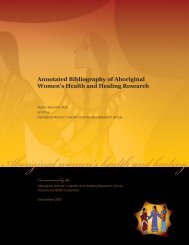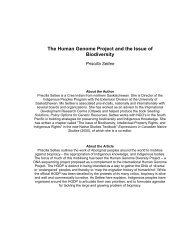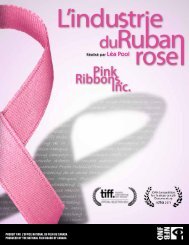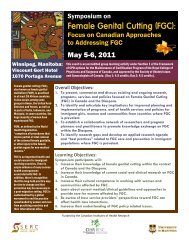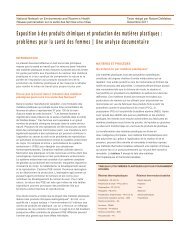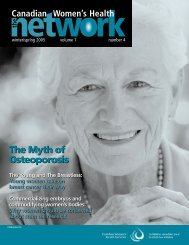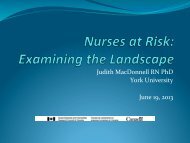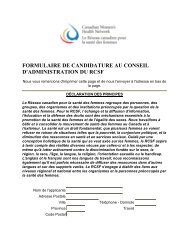here. - Canadian Women's Health Network
here. - Canadian Women's Health Network
here. - Canadian Women's Health Network
- No tags were found...
Create successful ePaper yourself
Turn your PDF publications into a flip-book with our unique Google optimized e-Paper software.
Women, Income and<strong>Health</strong> in Manitoba47situation of health care service delivery forAboriginal women. <strong>Health</strong> Canada, andmore particularly, its Medical ServicesBranch were the main topic ofdissatisfaction for Aboriginal women.Hospitals and hospital care were alsothe subject of scrutiny by those workingin health professions.Much resentment was expressed over theinterviewees’ experience of the testing ofdrugs such as Depo Provera on Aboriginalwomen, and young Aboriginal women inparticular. Many of the women expressedanger at what they described as Aboriginalwomen being used as ‘guinea pigs’ fordrug and other medical testing and thatdrugs are prescribed to Aboriginal womenwithout obtaining their informed consent.The example of a young Aboriginal womanwho had been the subject of a case studyfor some time was raised. She wasdescribed as one of the youngest peopleto ever be diagnosed with diabetes.Unfortunately, this young woman died atthe age of twenty-four. The women wantedto know why she died of renal failure, whenso much testing and research was done onher. One woman angrily suggested thatAboriginal people are treated like guineapigs because the government feels thatthey are expendable.Shortages of nurses in hospitals was alsoidentified as a serious problem in thehealth care system.In terms of existing programs, theinterviewees noted that t<strong>here</strong> are little orno health programs geared specificallytowards Aboriginal women.The interviewees described significantdissatisfaction with Medical ServicesBranch and a general sense that theMedical Services Branch has eroded rightsguaranteed in treaties. Concerns wereexpressed about the many cut-backs thathave been made to non-insured healthbenefits. It was noted however, that t<strong>here</strong>is a special needs program for non-statuspeople who can not afford to pay for theirprescriptions. It requires that an exemptionform be filled out and unfortunately mostpeople are not aware of this and ot<strong>here</strong>xisting programs. It was suggested thatpoor women are faced with the impossiblechoice of deciding whether to buymedication or food.The strict guidelines of the MedicalServices Branch were also seen asproblematic. For example, if an Aboriginalperson from a rural community or FirstNation is terminally ill in hospital, familymembers would not be able to come andsupport that person, since the MedicalServices Branch will only allow oneescort, and that only in extremesituations. One woman said thatsometimes a patient is left to die aloneand that it is “really inhumane”.Many women had complaints about theracist and discriminatory treatment thatAboriginal women receive in Winnipeghospitals, particularly during child birth.Of the three Winnipeg hospitals w<strong>here</strong>women give birth, the St. Boniface Hospitalwas identified as the best overall. At theother facilities, the interviewees felt thatstaff racism was an issue.Several complaints were made about theway in which Aboriginal women weretreated. Aboriginal midwives, were not yetlicensed to practice in Manitoba at the timeof these interviews. (Midwifery legislationwas proclaimed in Manitoba in May, 2000.)The interviewees felt that Aboriginalwomen are not respected by hospital staff.An interviewee described an incidentw<strong>here</strong> hospital staff wanted to immediatelyperform a D&C (dilation and curettage) ona pregnant Aboriginal woman, who wasbleeding early in her pregnancy. Theinterviewee felt that Caucasian womenwould have been offered an ultrasound todetermine the status of her pregnancy,rather than immediately terminating it.Other incidents were also described w<strong>here</strong>Aboriginal women were given large dosesof analgesics during labour. One case that




